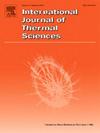Simulation study on flame characteristics and heat transfer mechanisms of a rectangular fire source attached to a pyrolysis wall
IF 4.9
2区 工程技术
Q1 ENGINEERING, MECHANICAL
International Journal of Thermal Sciences
Pub Date : 2025-06-16
DOI:10.1016/j.ijthermalsci.2025.110083
引用次数: 0
Abstract
To investigate the flame characteristics and heat transfer mechanisms of a rectangular fire source attached to a pyrolysis wall of PMMA, a numerical study was conducted on fire sources with varying burner aspect ratios and heat release rates. The results indicate that numerical simulation effectively captures the evolution of flame morphology and the changes in the solid pyrolysis region. The study found that under pyrolysis conditions, the flame temperature near the PMMA wall gradually increases during the initial stage, while in the later stages of combustion, the near-wall flame temperature begins to decrease. Meanwhile, changes in the burner configuration affect the pyrolysis process, leading to variations in the onset range of the temperature decrease near the wall at different heights. Additionally, changes in the aspect ratio and heat release rate influence flame characteristics, causing distinct impacts on heat transfer to the pyrolysis wall. Increasing the aspect ratio reduces the incident radiative heat flux received by the wall, altering the contribution of the highest temperature range to the mass loss rate. In contrast, increasing the heat release rate has a smaller effect on the heat flux distribution across the PMMA panel during the steady stage. Instead, it accelerates the PMMA pyrolysis process, thereby increasing the total volume percentage of temperature ranges above the pyrolysis temperature, which in turn increases the mass loss rate. However, it has minimal effect on the contribution of the highest temperature range to the mass loss rate.
附在热解壁上的矩形火源火焰特性及传热机理的模拟研究
为了研究PMMA热解壁上矩形火源的火焰特性和传热机理,对不同燃烧器长径比和放热速率的火源进行了数值研究。结果表明,数值模拟有效地捕捉了固体热解区域火焰形态的演变和变化。研究发现,在热解条件下,PMMA壁面附近火焰温度在初始阶段逐渐升高,而在燃烧后期,近壁面火焰温度开始下降。同时,燃烧器配置的变化会影响热解过程,导致不同高度壁面附近温度下降的起降幅度不同。此外,长径比和放热速率的变化会影响火焰特性,对热解壁面的换热有明显的影响。增大长径比降低了壁面接收的入射辐射热通量,改变了最高温度范围对质量损失率的贡献。相比之下,在稳定阶段,增加放热率对PMMA面板上的热流密度分布的影响较小。相反,它加速了PMMA的热解过程,从而增加了热解温度以上温度范围的总体积百分比,从而增加了质量损失率。然而,它对最高温度范围对质量损失率的贡献影响很小。
本文章由计算机程序翻译,如有差异,请以英文原文为准。
求助全文
约1分钟内获得全文
求助全文
来源期刊

International Journal of Thermal Sciences
工程技术-工程:机械
CiteScore
8.10
自引率
11.10%
发文量
531
审稿时长
55 days
期刊介绍:
The International Journal of Thermal Sciences is a journal devoted to the publication of fundamental studies on the physics of transfer processes in general, with an emphasis on thermal aspects and also applied research on various processes, energy systems and the environment. Articles are published in English and French, and are subject to peer review.
The fundamental subjects considered within the scope of the journal are:
* Heat and relevant mass transfer at all scales (nano, micro and macro) and in all types of material (heterogeneous, composites, biological,...) and fluid flow
* Forced, natural or mixed convection in reactive or non-reactive media
* Single or multi–phase fluid flow with or without phase change
* Near–and far–field radiative heat transfer
* Combined modes of heat transfer in complex systems (for example, plasmas, biological, geological,...)
* Multiscale modelling
The applied research topics include:
* Heat exchangers, heat pipes, cooling processes
* Transport phenomena taking place in industrial processes (chemical, food and agricultural, metallurgical, space and aeronautical, automobile industries)
* Nano–and micro–technology for energy, space, biosystems and devices
* Heat transport analysis in advanced systems
* Impact of energy–related processes on environment, and emerging energy systems
The study of thermophysical properties of materials and fluids, thermal measurement techniques, inverse methods, and the developments of experimental methods are within the scope of the International Journal of Thermal Sciences which also covers the modelling, and numerical methods applied to thermal transfer.
 求助内容:
求助内容: 应助结果提醒方式:
应助结果提醒方式:


